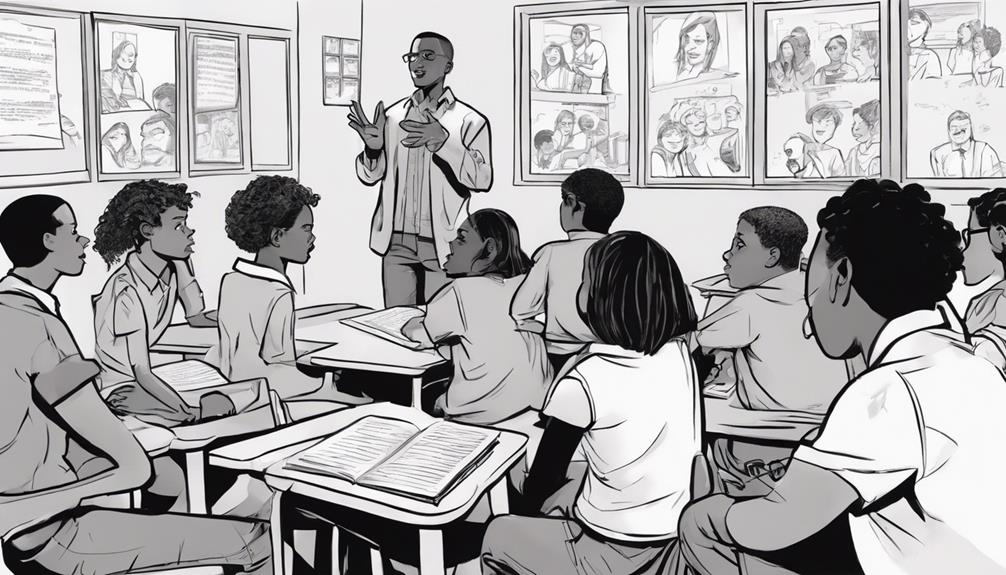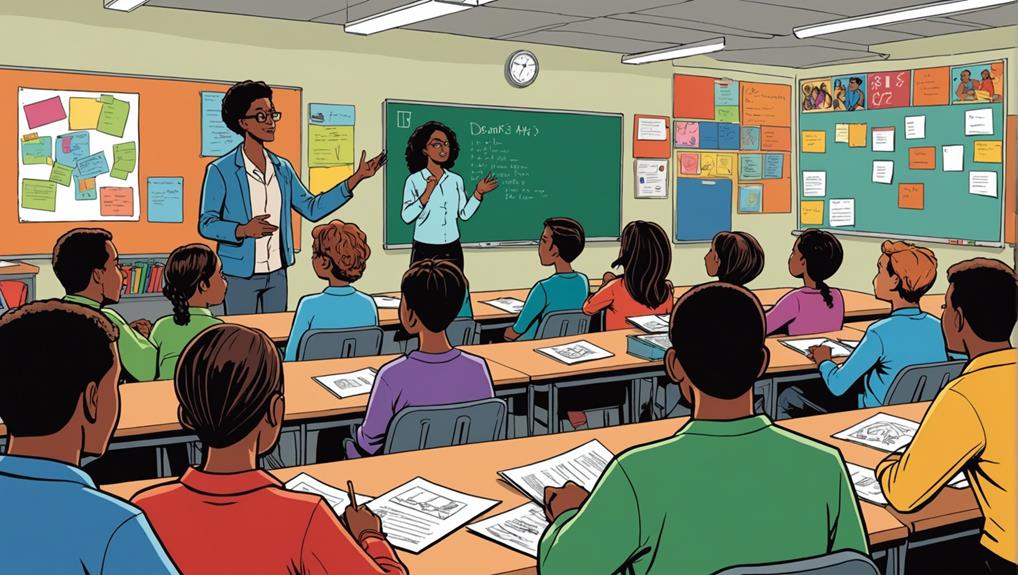Effective classroom communication is essential to successful teaching. Teacher speaking time is important for engaging students, sharing knowledge, and managing classroom dynamics. Engaging in dynamic discussions, providing explanations, and giving feedback are fundamental components. Challenges may arise in balancing teacher and student speaking roles, but practical applications include welcoming students, offering feedback, and varied lesson delivery methods like group work and multimedia presentations. Joining the teaching community offers networking opportunities, access to exclusive content, and engaging in discussions on best practices. Engaging with this key aspect of teaching guarantees a vibrant and successful classroom environment.
Key Takeaways
- Balancing Teacher Talking Time with student participation enhances learning.
- Effective TTT aids in providing explanations, feedback, and instructions.
- Varying lesson delivery methods keeps students engaged and caters to diverse learning styles.
- Teacher's speaking style impacts student engagement and comprehension.
- Collaborating with fellow educators fosters professional growth and enhances teaching practices.
Importance of Teacher Talking Time

Teacher Talking Time (TTT) plays a pivotal role in classroom success, serving as a fundamental element in facilitating student learning and comprehension.
It is through TTT that teachers provide essential information like grammar rules and vocabulary meanings, ensuring students grasp key concepts effectively. TTT allows for explanations, corrections, and complements student-led inquiry by engaging students with voice inflections and directed tasks.
Additionally, TTT is essential for tasks like verbal feedback, instructions, praise, and behavior management, creating a conducive learning environment.
Challenges With Official Recommendations

When considering the implementation of guidelines, educators encounter challenges with official recommendations in achieving a balanced balance between student and teacher speaking roles.
Official advice often suggests a specific student-teacher speaking ratio, such as the commonly cited 70/30 split, which may not always be practical in real classroom settings.
Additionally, while research on Teacher Talking Time (TTT) in English teaching is abundant, its direct applicability to other subjects can be limited.
Striking the right balance between student-led inquiry and teacher-directed tasks poses a significant challenge, especially when catering to the diverse needs of students at different proficiency levels.
Finding a middle ground that allows for effective communication, feedback, and knowledge dissemination remains a key hurdle for educators aiming for optimal classroom dynamics.
Practical Applications of TTT

Effective implementation of Teacher Talking Time (TTT) in educational settings involves various practical applications that enhance student engagement and learning outcomes. Teachers utilize TTT for welcoming students, offering feedback, giving instructions, praising students, managing spatial tasks, and directing learning activities. TTT is vital for real-time prompts, explanations, and behavior management techniques. Additionally, teachers talk to teach, describe, compare, and evaluate content for assessments. Effective lessons often involve a significant amount of TTT to guarantee clarity and understanding. Below is a table showcasing some practical applications of TTT in the classroom:
| Practical Applications of TTT |
|---|
| Welcoming students |
| Offering feedback |
| Giving instructions |
| Praising students |
Variety in Lesson Delivery

Diversifying instructional methods enhances the effectiveness of classroom lessons. Incorporating a variety of teaching approaches keeps students engaged and caters to different learning styles.
By mixing traditional lectures with interactive activities, group work, multimedia presentations, and hands-on experiments, educators can create dynamic and stimulating learning environments. This variety not only prevents monotony but also helps reinforce key concepts through different mediums.
Students are more likely to stay focused and retain information when lessons are delivered in diverse ways. Additionally, varying lesson delivery allows teachers to cater to the individual needs of students, ensuring that every learner has the opportunity to excel.
Embracing different methods keeps the classroom lively and promotes a deeper understanding of the material.
Join the Teaching Community

Exploring opportunities to engage with like-minded educators and gain valuable insights, consider joining the Richard James Rogers online teaching community for updates on resources, events, and educational discussions. The community offers a platform for teachers to connect, share ideas, and collaborate on various educational topics. By joining, you can access exclusive content, participate in engaging conversations, and stay informed about the latest trends in teaching. Interact with a diverse group of educators, including Richard James Rogers, a highly experienced teacher and author, to enhance your teaching skills and expand your professional network. Join the community today to be a part of a supportive and dynamic group of educators dedicated to improving teaching practices and student outcomes.
| Benefits of Joining the Teaching Community | Features Offered |
|---|---|
| Networking with like-minded educators | Updates on resources and events |
| Access to exclusive educational content | Engaging discussions on teaching practices |
| Opportunity to collaborate on educational projects | Direct interaction with Richard James Rogers |
Frequently Asked Questions
How Can Teachers Balance TTT With Student Participation Effectively?
Balancing Teacher Talking Time (TTT) with student participation effectively requires a strategic approach. Teachers should aim for a dynamic mix of TTT for explanations, feedback, and instructions, while also fostering student engagement through interactive tasks, discussions, and group work.
What Strategies Can Teachers Use to Minimize Excessive TTT in Lessons?
To minimize excessive Teacher Talking Time (TTT) in lessons, educators can employ strategies like incorporating student-led discussions, utilizing group work, integrating multimedia resources, implementing think-pair-share activities, and encouraging student presentations for enhanced engagement and participation.
Are There Specific Subject Areas Where TTT Is More Beneficial?
In certain subject areas like mathematics and science, Teacher Talking Time (TTT) is especially valuable for providing detailed explanations, modeling problem-solving techniques, and clarifying complex concepts. TTT plays a significant role in facilitating understanding and mastery in these disciplines.
How Can Teachers Incorporate Student-Led Inquiry While Maintaining Ttt?
Incorporating student-led inquiry while maintaining Teacher Talking Time (TTT) requires strategic task design. Balance TTT for clarifications, feedback, and behavioral guidance, and integrate student-led tasks for inquiry, critical thinking, and active learning. Engage students effectively through this dynamic approach.
What Are Some Practical Tips for New Teachers to Improve TTT Effectiveness?
To enhance Teacher Talking Time (TTT) effectiveness, new teachers can focus on clear explanations, varied voice inflections, concise instructions, and timely feedback. Incorporating a balance of TTT with student engagement strategies guarantees effective communication and understanding.
Conclusion
In the symphony of classroom dynamics, the teacher's speaking plays the vital role of a conductor, guiding students towards harmonious learning.
Just as a maestro leads an orchestra with precision and passion, educators must strike a balance between sharing knowledge and fostering student engagement.
By mastering the art of Teacher Talking Time, teachers can orchestrate a symphony of success in their classrooms, where every student finds their unique melody of academic achievement.









